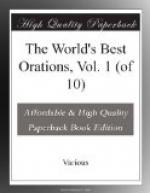“But the intent or guilty knowledge must be brought directly home to the defendant.” (Wharton’s American Criminal Law, 635)
“When an act, in itself indifferent, becomes criminal, if done with a particular intent, then the intent must be proved and found,” (3 Greenleaf, section 13.)
In the light of these principles, let us examine the evidence as it affects Mrs. Surratt. 1. What are the acts she has done? The specification against her, in the general charge, is as follows;—
“And in further prosecution of the said conspiracy, Mary E. Surratt did, at Washington City, and within the military department and military lines aforesaid, on or before the sixth day of March, A.D. 1865, and on divers other days and times between that day and the twentieth of April, A.D. 1865, receive and entertain, harbor and conceal, aid and assist, the said John Wilkes Booth, David E. Herold, Lewis Payne, John H. Surratt, Michael O’Laughlin, George A. Atzerodt, Samuel Arnold, and their confederates, with knowledge of the murderous and traitorous conspiracy aforesaid, and with intent to aid, abet, and assist them in the execution thereof, and in escaping from justice after the murder of the said Abraham Lincoln, as aforesaid.”
The first striking fact proved is her acquaintance with John Wilkes Booth—that he was an occasional visitor at her house. From the evidence, if it can be relied on, it distinctly appears that this acquaintance commenced the latter part of January, in the vicinage of three months only before the assassination of the President, and, with slight interruptions, it was continued down to the day of the assassination of the President. Whether he was first invited to the house and introduced to the family by Weichmann, John H. Surratt, or some other person, the evidence does not disclose. When asked by the judge advocate, “Whom did he call to see,” the witness, Weichmann, responded, “He generally called for Mr. Surratt—John H. Surratt— and, in the absence of John H. Surratt, he would call for Mrs. Surratt.”
Before calling the attention of the commission to the next evidence of importance against Mrs. Surratt, we desire to refresh the recollection of the court as to the time and manner, and by whom, according to the testimony of Lloyd, the carbines were first brought to his (Lloyd’s) house.
From the official record the following is taken:—
Question.—Will you state whether or not some five or six weeks before the assassination of the President, any or all of these men about whom I have inquired came to your house?
Answer.—They were there.
Q.—All three together?
A.—Yes; John H. Surratt, Herold, and Atzerodt were there together.
Q.—What did they bring to your house, and what did they do there?
A.—When they drove up there in the morning, John H. Surratt and Atzerodt came first; they went from my house and went toward T. B., a post office kept about five miles below there. They had not been gone more than half an hour when they returned with Herold; then the three were together—Herold, Surratt, and Atzerodt.




